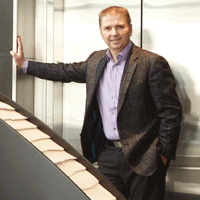Jean-Yves Germain talks hotel investment and the family business
A year ago, amidst dire predictions and Chicken Little hysteria from pundits and financial prognosticators, it was hard to imagine a hotel company actively building a portfolio of new properties. While conventional wisdom at the time said easy access to capital was a thing of the past, particularly in the hotel marketplace, one Quebec-based company boldly forged ahead, determined to stake its claim on city skylines from coast to coast. And, while the difficult financial ride hasn’t reached an end just yet, it’s now more difficult than ever to blight the bright future of Groupe Germain.
If the past three quarters of 2009 had few noticeable highlights for the Quebec City-based company, 2010 might already be a banner year, with the January opening of Hotel Le Germain Calgary. The $150-million project represents a significant step forward in the growth of the already successful company, as it becomes the first property in the portfolio to encompass a 143-room signature Germain boutique hotel experience, with private residences and corporate office space all under one roof.
“We think we’re offering a great product in Calgary,” says Jean-Yves Germain, the company’s co-president, and the man in charge of development plans and financing. (He’s also the construction supervisor for both Le Germain and ALT brands.) “It’s our first completed mixed-use project, with a hotel, condos and office space,” he adds. “More importantly, it’s a unique product for the city.”
For every city the company selects for development, providing something unique is part of the corporate ethos, as is the one factor that Germain and other top builders and investors seemingly repeat as a mantra: location, location, location. “The most important factor is to find a fantastic location,” he says. “It takes a lot of time and a lot of trips to any given city. In fact, that’s why we don’t have a Vancouver project finalized just yet. We haven’t found the perfect location.”
Unfortunately, even if you’ve targeted a brilliant site, your work has only just begun. “Once you find that perfect location, you’ll often discover that whoever owns the real estate, knows it’s a great location and doesn’t want to sell it. We try and co-operate with those types of land owners, to build something that works for everyone.”
Currently, what seems to work best for everyone — bankers included — are large multi-use structures. Germain says if you want to build a five-star property today, there’s almost no way around the condominium/retail/office/hotel consortium. “The trend of building multi-use projects like our Calgary and Toronto hotels is a result of the new economic climate, and how expensive it is to build,” he says. “If you want to develop a large-scale five-star property on its own, without any mixed-use element, the numbers don’t work.”
In the company’s two largest projects — the one in Calgary and Toronto’s $500-million Maple Leaf Square development, where Groupe Germain was brought in to manage the hotel component — Groupe Germain stuck close to the playbook, adding its new hotels as part of massive, multi-use properties in prime digs. In Toronto, the downtown hotel is literally connected to the Air Canada Centre, home to both the Leafs and the Raptors, as well as two new residential towers. Office, retail space and a massive sports bar are also pegged for the site. “We have fantastic partners in Maple Leaf Sports and Entertainment and Cadillac Fairview, for the Maple Leaf Square project, and that property will be a great centre for the area,” he says. “Also, with about 250 activities every year at the Air Canada Centre, it’s a big item, and a marvelous opportunity for the hotel.”
But how did this family run business manage to operate in some of Canada’s best real estate in the midst of a global economic meltdown and, more impressively, keep the construction moving along? That’s where Germain and his careful finance model really shine.
Years ago, when the tender went out for a project on a prime section of 9th Avenue Calgary real estate, a development firm could have leveraged itself to the hilt to snag the deal. But if it had, it likely would have struggled mightily to finish the project (see: Ritz-Carlton Vancouver) during the economic turmoil of the last 18 months. Not so for Groupe Germain, though the co-president concedes it wasn’t easy, and the company benefited from some fortune along the way. “Money in our industry is not easy to come by,” Germain starts. “At the time we were putting together our equity for the Calgary project, money was not as expensive to borrow, so there were probably five to 10 lenders across the country able or willing to put up that kind of a loan. Today, there are maybe two or three that could do it. In fact, if we were doing the same deal today, I don’t think we could find the loans. People just don’t have the appetite for it,” he says.
Conversely, lenders still crave the opportunity to enter into business with a developer that puts its money where its mouth is. That’s exactly what Germain says his team has been able to do, by carefully building its own equity funds to go to the table with some cash of its own. “Today, the only way to do it is to create funds, bring different people into the fold, and put in your own equity,” he says, of his company’s broad corporate mandate to be equity stakeholders in its own projects. “Some people think we’re crazy for doing that, but I think it gives our investors the confidence that we’ll be there, and it also provides a lot of upside as well,” he adds. Groupe Germain is looking forward to the returns on its approximately 27-per-cent stake in the new Calgary property, as well as the 12 to 50 per cent range it shoots for in all ventures.
Behind the glitz and glamour of the company’s signature line of luxury boutique hotels, lies an arguably more ambitious project in the works: the expansion of its ALT brand. ALT hotels combine a cool, urban-chic aesthetic with fixed $129-per-night rates, available any time of the year. “We expect to start the Toronto airport ALT property this spring, and we’re looking at another 22 markets across Canada,” says Germain, quite confidently for a financier about to commit hundreds of millions of dollars to expand a brand that’s largely untested on the national stage.
However, Germain is quick to note that while the roll-out plan is indeed bold, the ALT brand, by virtue of its business model and size, is actually more attractive to a higher number of potential investors or lenders. “Our ALT brand is a different story,” he says, in comparison to the trials of finding capital for the company’s larger projects. “It’s a smaller scale project, [requiring] a smaller budget, usually in the mid-$20-million range; therefore, maybe four or five different lenders could have an interest in a project that size,” he adds. And, of course, given Groupe Germain’s commitment to building up its own funds, he says there’s a greater attraction for banks to take the risk. “If you have the equity, you can find the money,” he says.
That’s sage advice that could have been very useful in the days and months prior to the global economic crash, spurred by a lending world gone mad.
Photography by Charles Hope





















